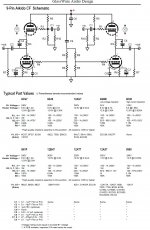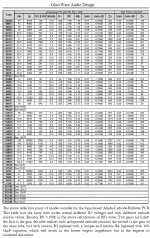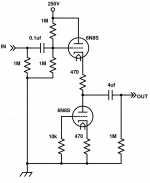Hello folks,
I have a Glassware PS1 regulated PSU kit and a ACF 9 pin Cathode follower kit on its way to me and I am doing some planning on the other parts for this build.
I have seen the chart detailing output impedances of the various valve options but I am a little unsure what sort of input impedances I would be looking at with the cathode follower kit.
I haven't quite decided on the valves but 6CG7 or 6DJ8 is probably what I will go for.
I am looking at options for potentiometers and will probably use a shunt stepped attenuator. Would a 100K series resistor based shunt POT be a good bet in the ACF 9 pin with 6CG7 and 6DJ8?
One of my sources has a relatively high output impedance at around 3.5K.
Many thanks in advance!
I have a Glassware PS1 regulated PSU kit and a ACF 9 pin Cathode follower kit on its way to me and I am doing some planning on the other parts for this build.
I have seen the chart detailing output impedances of the various valve options but I am a little unsure what sort of input impedances I would be looking at with the cathode follower kit.
I haven't quite decided on the valves but 6CG7 or 6DJ8 is probably what I will go for.
I am looking at options for potentiometers and will probably use a shunt stepped attenuator. Would a 100K series resistor based shunt POT be a good bet in the ACF 9 pin with 6CG7 and 6DJ8?
One of my sources has a relatively high output impedance at around 3.5K.
Many thanks in advance!
Ordinary cathode followers have high input impedance, which can be very high if the grid bias resistor is bootstrapped. I have no idea about the "Aikido Cathode Follower". Show us the circuit? Or provide a link.
Hi and many thanks for the reply!
I guess it would defeat the object of this being a buffer if it did not offer a high input impedance.
It does state the following in the instructions that I found on the glassware audio website.
"This unity-gain buffer, using a modified cathode follower, offers a high input
impedance and a low output impedance and low distortion and great PSRR."
I have attached the schematic and also the table with the part values for the different valves that can be used in this circuit.
I guess it would defeat the object of this being a buffer if it did not offer a high input impedance.
It does state the following in the instructions that I found on the glassware audio website.
"This unity-gain buffer, using a modified cathode follower, offers a high input
impedance and a low output impedance and low distortion and great PSRR."
I have attached the schematic and also the table with the part values for the different valves that can be used in this circuit.
Attachments
Input impedance will be approximately given by R2, R5 and R10 in parallel - so 333k if they are all 1M.
In my experience with the Aikido circuits: 6CG7 = warm and tubey, 6DJ8 = much more incisive (depending on tube chosen). Russian reissue E88CC Genalex is a decent sounding tube. Avoid the ECG Philips (and others of similar USA manufacture). The sound is dreadful.
6DJ8 will have a lower output impedance than a 6CG7, see Zo on the chart. Also you can run 6DJ at 150 to 200 volts where the 6CG usually runs 250 to 350, if that makes any different to you.
Steve With no annoying tag line. Oops.
6DJ8 will have a lower output impedance than a 6CG7, see Zo on the chart. Also you can run 6DJ at 150 to 200 volts where the 6CG usually runs 250 to 350, if that makes any different to you.
Steve With no annoying tag line. Oops.
If you build it point to point like I do or you get an adaptor a 5670/6N3P is great with a 220R R3/R6 250V.
My opinion, no. Others might disagree but I've never understood the point of using a choke where there is (almost) no current flow.
Yeah, after I bought the things I got to wondering the same thing but haven't got around to try them out - maybe I'd better just do that and see for some piece of mind!
R7 appears to be merely a ground leak for the output coupling cap. Replacing it with a choke would give quicker stabilisation of output DC voltage, and would narrow the bandwidth and increase distortion - although not by much. Hard to see how this might be a good idea.
In my experience with the Aikido circuits: 6CG7 = warm and tubey, 6DJ8 = much more incisive (depending on tube chosen). Russian reissue E88CC Genalex is a decent sounding tube. Avoid the ECG Philips (and others of similar USA manufacture). The sound is dreadful.
6DJ8 will have a lower output impedance than a 6CG7, see Zo on the chart. Also you can run 6DJ at 150 to 200 volts where the 6CG usually runs 250 to 350, if that makes any different to you.
Steve With no annoying tag line. Oops.
Thanks for this, I was actually thinking of asking for recommendations for tubes, but there are so many old Aikido threads asking similar questions that I thought folk might by tired of replying to such questions.🙂
I was looking at the table and 6DJ8 looks the best candidate from an output impedance point of view. Your description of 6DJ8 vs 6CG7 also suggests this would suit my system and taste better.
Any other recommendations for 6DJ8 or equivalent tubes would certainly be very welcome.
If you build it point to point like I do or you get an adaptor a 5670/6N3P is great with a 220R R3/R6 250V.
I had thought about point to point and would like to do this ideally, but would not feel confident so I have gone with the full kits including PCBs. Actually, reading as much as I can on these forums about the Aikido kits is making me feel a little nervous about the build!
I have successfully put together a good number of kit based projects previously, but they have generally been more straight forward in that there were fewer or no options and "forks in the road" as such. I also keep coming across mentions of bags being labelled incorrectly or mistakes in the instructions / schematics with the glassware kits.
One minor flaw with some of the Aikidos....
Is that sometimes tube designators will be reversed. For instance V1, the input tube for one channel will be labelled V2, the input tube for the other, and vise versa. It can drive you a bit nuts if you are trying to compare the board to the schematic.
The instructions are fairly basic, you don't get the "Heathkit" style of detail.
I've not had any parts mislabelled but you might get several values for some of the resistors. You choose depending on the tube you use or in the case of a power supply the output voltages you want.
See the following for details on an Aikido build and 6DJ8 tube shootout.
Cheers, Steve (first snow of the season here last night )
)
Battle of the Cheap Line Stages – Part 1 | Wall of Sound | Audio and Music Reviews
Vacuum Tube Shootout: 6DJ8 types (part 1) | Wall of Sound | Audio and Music Reviews
Vacuum Tube Shootout: 6DJ8 types (part 2) | Wall of Sound | Audio and Music Reviews
Is that sometimes tube designators will be reversed. For instance V1, the input tube for one channel will be labelled V2, the input tube for the other, and vise versa. It can drive you a bit nuts if you are trying to compare the board to the schematic.
The instructions are fairly basic, you don't get the "Heathkit" style of detail.
I've not had any parts mislabelled but you might get several values for some of the resistors. You choose depending on the tube you use or in the case of a power supply the output voltages you want.
See the following for details on an Aikido build and 6DJ8 tube shootout.
Cheers, Steve (first snow of the season here last night
 )
)Battle of the Cheap Line Stages – Part 1 | Wall of Sound | Audio and Music Reviews
Vacuum Tube Shootout: 6DJ8 types (part 1) | Wall of Sound | Audio and Music Reviews
Vacuum Tube Shootout: 6DJ8 types (part 2) | Wall of Sound | Audio and Music Reviews
Thanks a lot for your help that's great. I shall have a good read of those threads.
The PS1 kit and the ACF kit have just been delivered an hour ago! I chose to get all of the resistors with the ACF so i should be covered for a few options. Just got to do some reading / planning I guess now.
The PS1 kit and the ACF kit have just been delivered an hour ago! I chose to get all of the resistors with the ACF so i should be covered for a few options. Just got to do some reading / planning I guess now.
There's also a thread on here about the ACF and how a lot of people can't get rid of a low level hum with the kit. Let us know how you fare.
There's also a thread on here about the ACF and how a lot of people can't get rid of a low level hum with the kit. Let us know how you fare.
Is that the version 2 of the ACF? I did see that on this and another forum.
I think the ACF2 with integrated bi polar PSU is different to the standard ACF.
If we are talking about the same kit and same problem, this is what i found regarding that issue which I think is specific to the ACF2 if I have understood correctly.
I was actually considering the ACF2 until i read this and a number of other posts about hum issues.
Removing hum from Aikido Cathode Follower (ACF-2 9-Pin) - diyAudio
I was actually considering the ACF2 until i read this and a number of other posts about hum issues.
Removing hum from Aikido Cathode Follower (ACF-2 9-Pin) - diyAudio
one thing I haven't quite got my head around when looking at the impedance of connected bits of kit is the output impedance. Are these also in parallel with each other in the same way that input impedance is?
In my example looking at the 333K input impedance of the Aikido ACF, this is in parallel with the input impedance of the POT that I chose, so if I use a 50K standard POT the source component sees 43472.58 ohms.
Is the output impedance of both the 50K POT (12.5K half volume highest point) and source (3.5K) in parallel? i.e. 2734.38 ohms?
In my example looking at the 333K input impedance of the Aikido ACF, this is in parallel with the input impedance of the POT that I chose, so if I use a 50K standard POT the source component sees 43472.58 ohms.
Is the output impedance of both the 50K POT (12.5K half volume highest point) and source (3.5K) in parallel? i.e. 2734.38 ohms?
Koda,
Did the simplified circuit meet your expectations of the sound?
Thanks Steve for the links to the reviews - very clear and surprisingly 'insightful' (if that's a word).
Did the simplified circuit meet your expectations of the sound?
Thanks Steve for the links to the reviews - very clear and surprisingly 'insightful' (if that's a word).
- Status
- Not open for further replies.
- Home
- Amplifiers
- Tubes / Valves
- Aikido Cathode Follower Input Impedance


